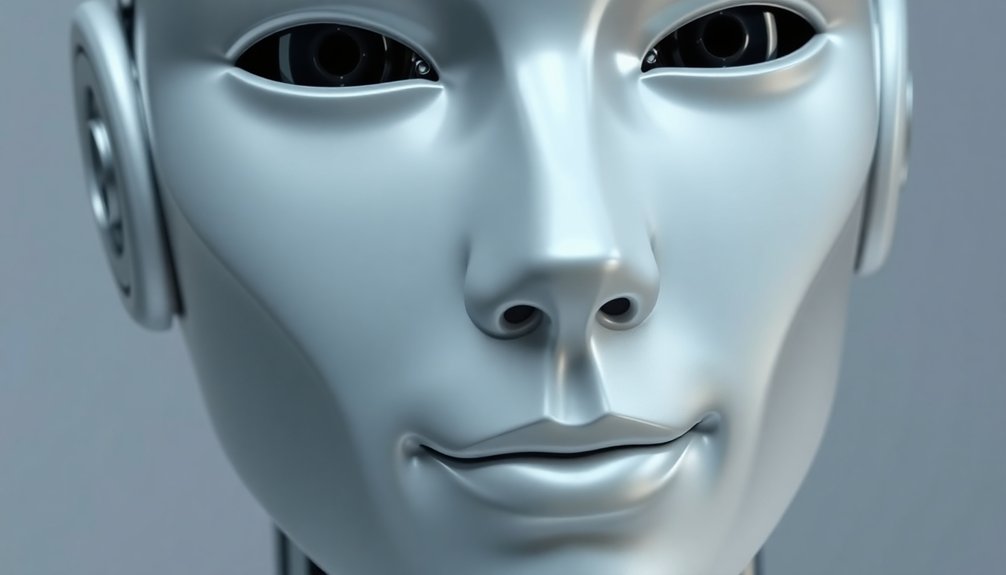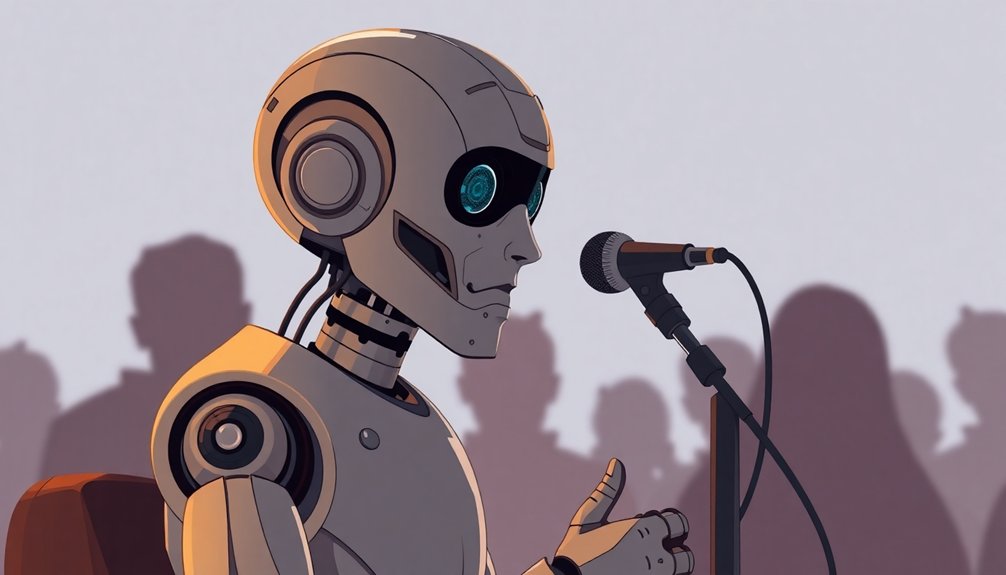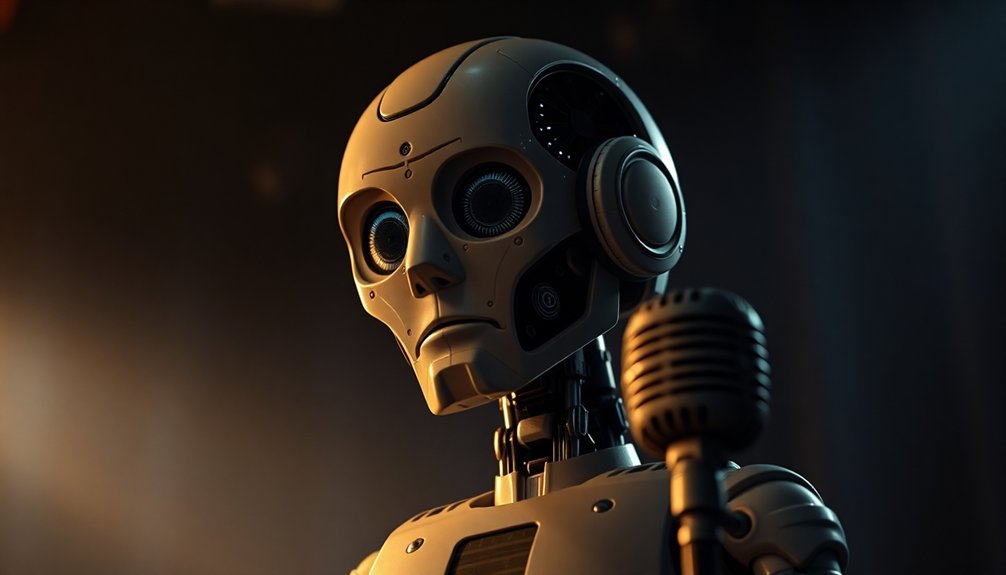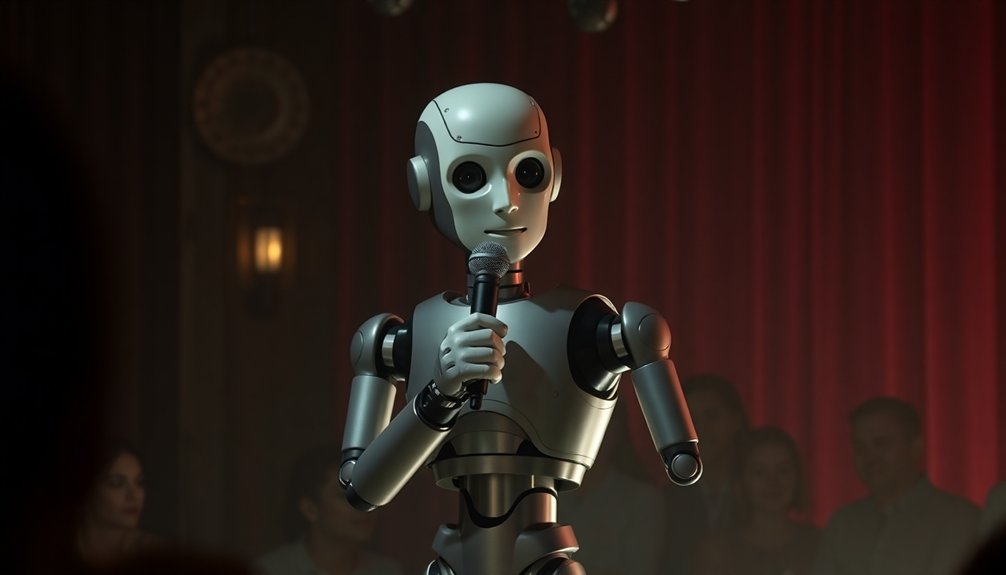Table of Contents
Robots are getting closer to cracking the comedy code, but they’re not headlining comedy clubs yet. They can analyze laughter, detect jokes, and even generate puns using neural networks. Think of them as awkward comedy interns learning the ropes—they understand patterns but miss the spontaneous magic of human humor. Can they genuinely be funny? Not quite. But they’re learning, and who knows what algorithmic comedy awaits? Stick around, and you might just witness the rise of the machine comedian.
Decoding Artificial Laughter

While robots might seem about as funny as a tax audit, AI researchers are cracking the code on artificial laughter—and it’s wilder than you’d expect.
They’ve built robots like ERICA that can detect and mimic human giggles using deep learning algorithms. Think of it like teaching a computer to understand the sound of joy.
Neural networks now analyze laughter patterns so precisely that robots can tell the difference between a chuckle and a full-blown guffaw. Imagine a machine that knows when you’re genuinely amused versus politely fake-laughing at your boss’s terrible joke.
AI can now decode laughter’s subtleties, distinguishing genuine mirth from polite social performance.
These AI systems use complex techniques like Connectionist Temporal Classification to decode the acoustic mysteries of human laughter. It’s not just about hearing—it’s about understanding the social signals hidden in our most spontaneous vocal expression.
The pursuit of robotic humor reflects a broader technological ambition to capture the nuanced social dynamics of human interaction, with researchers aiming to bridge the gap between mechanical precision and emotional authenticity. The research specifically demonstrates how AI models can be trained to recognize and generate laugh type classification with remarkable accuracy.
The Science Behind Robot Comedy
You’ve heard robots can make jokes, but have you wondered how they actually pull it off?
Laughter detection algorithms and semantic humor mapping are like digital comedy forensics, where machines dissect jokes the way a surgeon opens up a patient to understand what makes them tick. Advanced language models trained on extensive text data are now exploring computational humor techniques to decode the intricate mechanisms behind human comedy. AI models in recent studies demonstrate sophisticated capabilities in generating memes, yet still struggle with the nuanced human humor required for truly hilarious content.
Laughter Detection Algorithms
How do you teach a robot to laugh when something’s actually funny? Machine learning might’ve an answer. Researchers have cracked the code of laughter detection using neural networks that can spot a chuckle with 87% accuracy. Precise LSTM modeling allows these systems to analyze sequential audio inputs more effectively than traditional approaches.
It’s not magic—these algorithms analyze audio clips, breaking down laugh sequences like linguistic detectives. Think of it as training a digital comedian to recognize when jokes land.
The secret sauce? Massive datasets like Audioset, packed with millions of audio samples. By feeding computers balanced laugh-to-speech recordings, scientists are teaching machines to distinguish a genuine guffaw from polite titter.
Sure, today’s systems struggle with background noise, but they’re getting smarter. Imagine video calls where robots can finally understand when humans are genuinely amused—or just being awkward. Researchers are now leveraging pre-trained audio checkpoints from specialized datasets to improve laughter recognition algorithms.
Semantic Humor Mapping
Because teaching a robot to understand humor is like trying to explain a joke to your grandparent, semantic humor mapping represents a wild frontier of artificial intelligence.
It’s tricky business decoding the nuanced dance of context, emotion, and linguistic gymnastics that make something funny. Researchers are battling serious challenges: emotional ambiguity throws machine learning models for a loop, and context misinterpretation can turn potential comedy gold into awkward digital crickets.
Current approaches leverage emotional features like surprise and trust, using advanced XAI techniques to peek inside the “humor black box.” Humor detection models struggle with accurately capturing the complex cognitive processes that generate genuine laughter.
Semantic analysis techniques can help machines understand contextual and emotional layers underlying humor by analyzing linguistic patterns and inferring intent beyond literal meanings.
But can algorithms genuinely capture the spontaneous magic of a well-timed punchline? The quest continues, with digital humanities and mental health applications hanging in the balance.
Robots mightn’t laugh yet, but they’re getting closer.
Emotional Algorithms and Humor

While machines might seem about as funny as a tax audit, emotional algorithms are quietly revolutionizing how artificial intelligence understands humor. Computational linguistic techniques analyze massive datasets of conversational patterns to decode the nuanced mechanics of comedic expression. These clever codes dive deep into language patterns, detecting everything from sarcasm to subtle irony by analyzing speech features like pitch, speed, and contextual cues. Emotion AI can measure subconscious reactions and recognize emotional nuances that contribute to understanding comedic interactions. Neuromorphic computing enables robots to process humor more like the human brain, mimicking cognitive patterns of contextual understanding.
Think of it like teaching a robot to read between the lines. By processing massive joke databases and tracking emotional reactions, AI can now recognize when something’s supposed to be funny—even if it doesn’t always nail the punchline.
It’s not about memorizing jokes, but understanding the intricate dance of human communication.
Sure, machines won’t be headlining comedy clubs soon. But they’re getting scarily good at decoding our weird, wonderful sense of humor.
Bridging Human and Machine Amusement
You’ve probably wondered if robots can actually laugh or crack jokes without sounding like a malfunctioning GPS.
Imagine programming laughter into machines—not just pre-recorded chuckles, but genuine algorithmic humor that understands context, timing, and the subtle art of making humans crack up.
The frontier of robot humor isn’t about mimicking human comedy, but creating a new language of amusement where machine intelligence and human perception dance a strange, unpredictable waltz.
Robot Laughter Mechanics
When robots start to chuckle, it’s like watching a toddler learn to tell a joke—awkward, endearing, and slightly surreal.
They’re programmed to recognize humor’s subtle dance, detecting when humans burst into laughter and deciding whether to join the comedy party. It’s a complex algorithm of timing, gesture, and social intelligence.
Imagine a robot analyzing your joke’s punchline, calculating the perfect moment to release a synchronized laugh—lip corners lifting, shoulders slightly shaking.
But it’s not just about mimicry. These mechanical comedians are learning to differentiate between authentic mirth and nervous giggles, mapping human emotional landscapes one chuckle at a time.
Can they genuinely understand humor, or are they just sophisticated laugh-tracking machines? Neuromorphic computing enables robots to process emotional nuances more deeply, potentially cracking the code of comedic comprehension.
Humor Programming Frontiers
From mechanical chuckles to computational comedy, the frontier of humor programming isn’t just about making robots laugh—it’s about teaching machines to understand the art of the joke. You’re witnessing a wild technological tango where neural networks learn to dance with wit, substituting words and playing linguistic ping-pong with surprise. Neuromorphic computing enables these language models to process comedic patterns with increasing sophistication, mimicking the brain’s adaptive learning mechanisms.
| Approach | Technique | Potential |
|---|---|---|
| Word Swap | Pun Generation | Moderate |
| Context Modeling | Surprise Insertion | High |
| Pattern Mimicry | Style Replication | Growing |
AI’s humor horizon isn’t just algorithms—it’s a playground of linguistic gymnastics. Can machines genuinely grasp why we laugh? Probably not. But they’re getting scarily close, blending randomness with learned patterns that occasionally spark genuine amusement. The joke’s on us: robots might become comedy’s unexpected apprentices, one calculated chuckle at a time.
Challenges in Robotic Wit

Because robots aren’t known for their comedic genius, the quest to program a punchline-delivering machine is trickier than teaching your grandpa how to use TikTok.
Robots struggle with the spontaneity that makes humor human. Their pattern-based algorithms can’t capture the creative twists that make us laugh.
Imagine a robot trying to nail comedic timing—it’s like watching a toddler attempt stand-up comedy. Cultural nuances, emotional cues, and split-second improvisations are technological Mount Everests for machine wit. They can analyze joke structures but miss the soul of humor: that magical moment of unexpected connection.
Sure, algorithms can generate jokes, but can they read a room? Can they sense when a joke might bomb or when laughter is brewing? Not quite yet. Ethical decision-making in humor requires understanding complex human emotional contexts that current robotic systems struggle to comprehend.
Robotic humor remains a fascinating frontier of technological challenge.
Real-World Applications of Mechanical Humor
As robots inch closer to becoming our quirky technological companions, their newfound ability to crack jokes isn’t just a novelty—it’s a strategic game-changer. Humanoid robots are evolving beyond mere technological tools to become sophisticated emotional companions capable of nuanced social interactions. Imagine a warehouse where robots lighten the mood during monotonous tasks, or a hospital where mechanical comedians ease patient anxiety. They’re not just machines; they’re social lubricants transforming how we interact with technology. From manufacturing floors to entertainment stages, humor-equipped robots are breaking down communication barriers. They’re making complex interactions smoother, reducing workplace tension, and surprisingly, becoming more likable. Think about a robot that can turn a potential failure into a moment of shared laughter, or a chatbot that understands your sarcasm. These aren’t sci-fi fantasies—they’re emerging realities that challenge our understanding of machine intelligence and social dynamics.
The Future of Artificial Comedic Intelligence

Buckle up for a wild ride into the comedic AI frontier, where algorithms are learning to tickle our funny bones—and maybe our existential fears.
Can machines really understand why we laugh? Current AI might generate jokes, but they’re more like awkward comedy interns than seasoned comedians. They’ll analyze humor patterns, crunch linguistic data, and attempt witty responses—but something’ll always feel… off.
Imagine a robot trying to explain a pun: technical, precise, completely missing the point. The future isn’t about perfect joke generation, it’s about nuanced understanding.
We’re teaching machines to recognize cultural contexts, decode sarcasm, and maybe—just maybe—develop a comedic sensibility that doesn’t sound like it was programmed by an engineering textbook.
Humor’s complexity might just be AI’s ultimate challenge.
People Also Ask About Robots
Can Robots Truly Understand Why a Joke Is Funny?
You’ll struggle to make a robot authentically understand humor’s complexity. While AI can analyze jokes’ structures, it can’t grasp the nuanced emotional and cultural subtleties that genuinely make something hilarious.
Do Robots Have Emotions When They Laugh?
You’ll find robots don’t authentically laugh or feel emotions; they’re programmed to recognize humor patterns and generate responses that mimic laughter, simulating an emotional reaction without genuinely experiencing it.
Will Robots Replace Human Comedians in Entertainment?
Like Charlie Chaplin’s mechanical dance, robots might mimic comedy, but they’ll never genuinely replace human comedians. You’ll find their performances novelty acts—lacking the emotional depth, cultural nuance, and spontaneous wit that make laughter real.
How Do Cultural Differences Affect Robot Humor Perception?
You’ll find that cultural nuances dramatically shape how robots’ jokes are perceived, with humor’s effectiveness varying across societies due to language, social norms, and contextual interpretations that define comedic resonance.
Can Robots Learn Sarcasm and Complex Comedic Nuances?
Forsooth, you’re witnessing AI’s incredible journey! You’ll see robots increasingly decode sarcasm through advanced multimodal learning, though they’ll still struggle with nuanced cultural humor, capturing textual and contextual cues with growing sophistication.
Why This Matters in Robotics
You’ll soon find that robot humor isn’t just a quirky dream. By pure chance, as you’re pondering AI’s comedic potential, breakthroughs in emotional algorithms are already cracking the code. Robots might not replace stand-up comics yet, but they’re learning to understand wit, context, and timing. Your future laughs could come from silicon rather than flesh—strange how technology mirrors human creativity, isn’t it? Comedy, after all, is just complex pattern recognition.
References
- https://www.frontiersin.org/journals/robotics-and-ai/articles/10.3389/frobt.2024.1407095/full
- https://www.rockingrobots.com/research-robot-simulates-sense-of-humor/
- https://www.iotworldtoday.com/robotics/robot-taught-to-have-a-sense-of-humor
- https://dl.acm.org/doi/10.1145/3610978.3640710
- https://tmb.apaopen.org/pub/gybsu0dp/download/pdf
- https://www.sydney.edu.au/news-opinion/news/2024/06/03/the-jokes-on-us-ai-replicating-laughter-humour-expert.html
- https://www.psychologytoday.com/us/blog/the-future-brain/202209/ai-enabled-laughing-robots-are-no-joke
- https://local12.com/news/offbeat/laugh-detectors-funny-work-company-quota-cat-videos-ai-artificial-intelligence-chief-lol-officer-laughing-laughter-job-office-job-satisfaction-test-science-psychology-comedy
- https://www.ideo.com/journal/why-your-office-needs-a-laugh-detector
- https://www.isca-archive.org/interspeech_2023/matsuda23_interspeech.pdf
